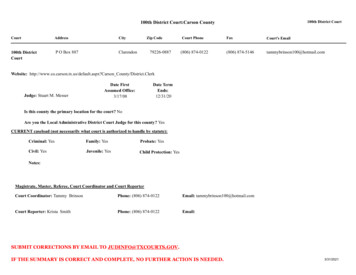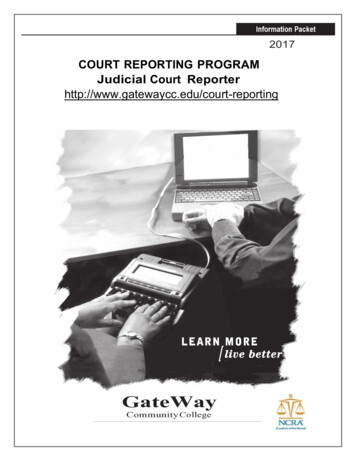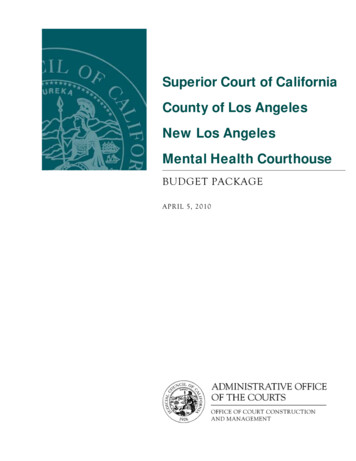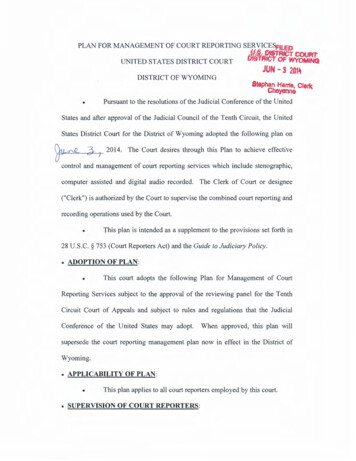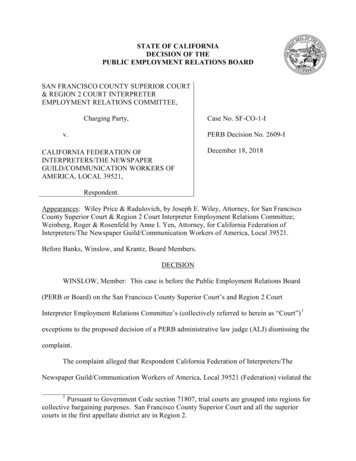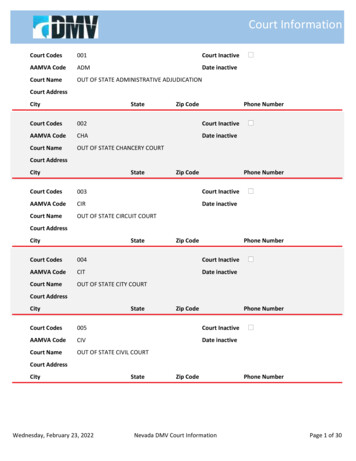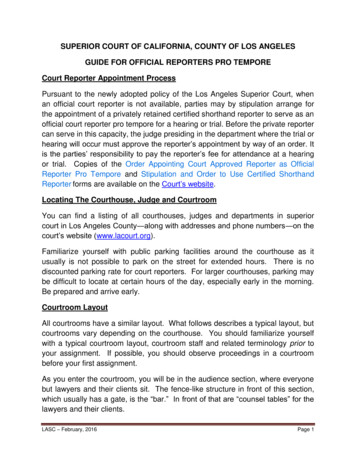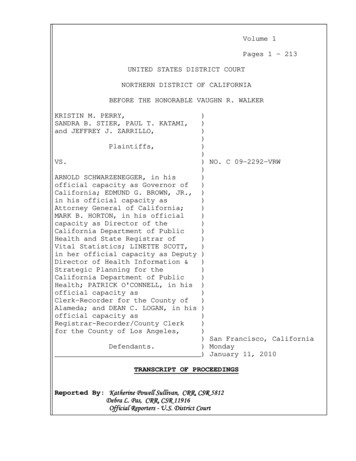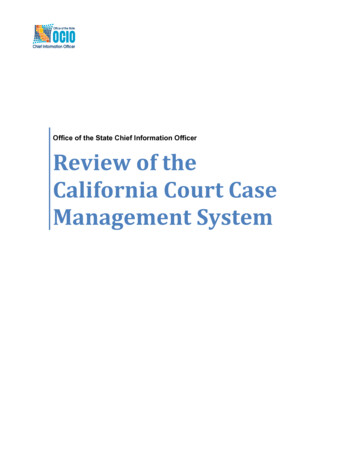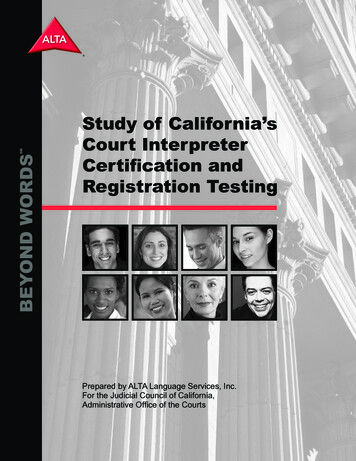
Transcription
BEYOND WORDSSM Study of California’sCourt InterpreterCertification andRegistration TestingPrepared by ALTA Language Services, Inc.For the Judicial Council of California,Administrative Office of the Courts
I . A N A LY S I S O F W O R K Q U A L I F I C AT I O N SThis report is produced for the Judicial Council of California, Administrative Office of the Courts,455 Golden Gate Avenue, San Francisco, CA 94102-3688.Copyright 2007 by Judicial Council of California/Administrative Office of the Courts. All rights reserved.Prepared for Judicial Council of California by ALTA Language Services, Inc., 3355 Lenox Road,Suite 510, Atlanta, GA 30326Except as permitted under the Copyright Act of 1976 and as otherwise expressly provided herein, no part of this publication may bereproduced in any form or by any means, electronic or mechanical, including the use of information storage and retrieval systems,without permission in writing from the copyright holder. Permission is hereby granted to nonprofit institutions to reproduce anddistribute this publication for educational purposes if the copies credit the copyright holder.For additional information, please contact:Lucy Smallsreed, SupervisorCourt Interpreters Program,Executive Office Programs Division,Administrative Office of the Courts455 Golden Gate AvenueSan Francisco, CA 94102courtinterpreters@jud.ca.govThis report is also available on the California Courts Web site: inted on 100% recycled and recyclable paper. Study of California’s Court Interpreter Certification and Registration Testing
Study of California’sCourt InterpreterCertification andRegistration TestingPrepared by ALTA Language Services, Inc.For the Judicial Council of California,Administrative Office of the Courts
I . A N A LY S I S O F W O R K Q U A L I F I C AT I O N S Study of California’s Court Interpreter Certification and Registration Testing
In June of 2006, the Judicial Council of California, Administrative Office of the Courts (AOC) contractedALTA Language Services, Inc. (ALTA) to analyze the examination process and testing instruments for thecertification and registration of California state court interpreters.ALTA was charged with analyzing the core work qualifications needed for the function of court interpreting,so as to develop recommendations regarding testing instruments and individual test items to measurethe determined qualifications. Additionally, ALTA examined test administration processes and maderecommendations pertaining to the overall administration of examinations. In an attempt to enhance thepool of qualified court interpreters, ALTA also addressed and developed recommendations pertaining to therecruitment and training of future candidates.After this thorough review of California’s program for certifying and registering court interpreters, ALTA hasfound that, while certain areas are in need of improvement, California’s current testing program is credentialingcourt interpreters whose knowledge, skills and abilities are well aligned with those needed to perform thejob at a high level of competence. The size and scope of California’s testing program, along with its years ofexperience, make California a recognized leader in the field. Implementing the recommendations containedin this report will serve to further enhance California’s court interpreter testing program, and to further evidenceCalifornia’s commitment to quality and leadership in this important aspect of service to the public.I . A N A LY S I S O F W O R K Q U A L I F I C AT I O N Sf o r wa r dSincerely,Chris Roosevelt, Ph.D.Vice-President of Testing and TrainingALTA Language Services, Inc.ALTA Language Services, Inc. Tel3355 Lenox Road, Suite 510Atlanta, GA 30326Faxwww.altalang.comEmailJocelyn EchevarriaProject DirectorALTA Language Services, ang.comStudy of California’s Court Interpreter Certification and Registration Testing
I . A N A LY S I S O F W O R K Q U A L I F I C AT I O N S Study of California’s Court Interpreter Certification and Registration Testing
Executive Summary.1Introduction: Project Scope and Deliverables.9I. Analysis of Work Qualifications.13Methodology.14Findings . .15Analysis.20Conclusions.21Recommendations.21II. Assessment of Current Testing Instruments.23Methodology.24Findings . .25Analysis.27Discussion of Analysis.29Conclusion.30Recommendations.31III. Assessment of Current Rating scussion of Analysis.38Conclusion.39Recommendations.39IV. Review of Test Structure and Administration scussion of Analysis.46Conclusion.48Recommendations.48V. Review of Available cussion of Analysis.55Recommendations.56VI. Review of Recruitment ussion of Analysis.61Recommendations.61Study of California’s Court Interpreter Certification and Registration TestingTA B L E O F C O N T E N T STa b l e o f C o n t e n ts
I . A N A L Y S I S O F W OTRAKB LQEU OAFLIFC IOCNATTEI ONNTSiiAppendices.63Appendix 1 – Literature Review.64Appendix 2 – Interpreter Interview Questions.68Appendix 3 – Stakeholder Interview Questions.77Appendix 4 – Interpreter Survey Questions.79Appendix 5 – Documents Reviewed and Assigned Levels.83Appendix 6 – The Use of an Oral Proficiency Assessment.89Appendix 7 – Test Format and Rating of Other Models.92Appendix 8 – Use of Scoring Units.94Appendix 9 – Additional Research on Simultaneous Interpretation.95Appendix 10 – Written and Oral Tests Used by Peer Models.100Appendix 11 – Written and Oral Tests Used by Other States.103Appendix 12 – Identification of Tiered Systems.106Appendix 13 – Test Retake Policies.109Appendix 14 – Tiered Placement Options . 111Appendix 15 – Training Programs in Other States. 114Appendix 16 – Interpreter Training Programs in California. 115Appendix 17 – Interpreter Training and Passage Rates. 118Study of California’s Court Interpreter Certification and Registration Testing
ExecutiveSummary
I . A N A LY S I S O F WeO xRecutiK Q U AvLeI F suI C AmTmI OaryNSThe Judicial Council of California, Administrative Office of the Courts (AOC) contracted ALTA LanguageServices, Inc. (ALTA) to analyze the examination process and testing instruments for the certificationand registration of California state court interpreters. Research conducted throughout the study assistedALTA in developing recommendations for future test design andadministration, as well as future recruitment and training efforts.Through the analysis of data obtained from qualitative interviewsand quantitative surveys, as well as examination of current testingand rating processes, ALTA identified the knowledge, skills, andabilities (KSAs) needed for the function of court interpretation,and assessed how well the current instruments align withdefined KSAs. Additionally, ALTA reviewed current test structureand administration practices, as well as interpreter training andrecruitment efforts of peer models that certify or qualify courtinterpreters, through analysis of data and reviews. Included inthis report are the findings, analyses, and recommendations inregard to future test instruments, administration practices, andtraining and recruitment efforts.Analysis of Work QualificationsIn the first stage of this study, an analysis of work requirementswas conducted to define the key functions of a state courtinterpreter and to create a profile of the requisite knowledge,skills, and abilities (KSAs) needed for the function of courtinterpretation. Findings from the research conducted in thisstage indicate that the job of the court interpreter requireshighly developed knowledge, skills, and abilities in a numberof different areas. To interpret for all oral messages andutterances, as well as to orally translate written documents,court interpreters must have a broad range of knowledge and highly competent abilities in the following skillareas:Linguistic SkillsSpeaking SkillsnListening Comprehension SkillsnReading Comprehension SkillsnInterpreting Skillsn Behavioral SkillsnnBased on the findings, the following knowledge, skills, and abilities were determined as essential for theperformance of court interpretation:Linguistic SkillsNative-like proficiency in all working languages;Ability to think and react communicatively in all working languages;nKnowledge and use of a broad range of vocabulary, including legalterminology, subject- specific terminology, and slang; andnKnowledge and use of cultural nuances, regional variations, idiomaticexpressions, and colloquialisms in all working languages.nn Study of California’s Court Interpreter Certification and Registration Testing
nnnAbility to speak with proper pronunciation, diction, and intonation in allworking languages;Ability to speak with a neutralized accent in all working languages; andAbility to project and/or speak softly.Listening Comprehension SkillsnnnAbility to listen to and comprehend different rates of speech in all workinglanguages;Ability to listen to and comprehend various regional accents and/or dialecticaldifferences in all working languages; andAbility to ignore auditory distractions and focus on source speaker.Reading Comprehension SkillsnnnAbility to read and comprehend overall meaning and specific details ofwritten text in all working languages;Ability to read and recognize various written contexts, including formaland informal text, subject-specific vocabulary, idiomatic expressions, andcolloquialisms; andAbility to read quickly and with little preparation.e x ecuti v e su m m arySpeaking SkillsInterpreting SkillsnnnnnnnnnnnnnnAbility to concentrate and focus;Ability to process linguistic information quickly;Ability to make quick linguistic decisions regarding word choice or terminologyselection;Ability to apply short-term memory skills in retaining small units ofinformation;Ability to think analytically;Ability to utilize predictive thinking skills to anticipate incoming messages;Ability to convey meaning;Ability to provide transference from one language to another;Ability to preserve accuracy;Ability to select appropriate equivalents for vocabulary or phrases;Ability to accommodate for lack of equivalents in vocabulary or phrases;Ability to conserve intent, tone, style, and utterances of all messages;Ability to reflect register; andAbility to self-monitor and self-correct.Behavioral SkillsnnnnnnAbility to practice and follow ethical standards;Ability to conduct business in a professional manner;Knowledge and awareness of cultural aspects that affect language;Ability to work in various settings, situations, or conditions;Ability to project self-confidence and self-awareness when interpreting; andKnowledge and continued learning of social, technological, and legalchanges that affect language. Diction refers to the ability to speak with clarity. Register refers to the ability to reflect the tone of the language being used, whether formal or informal.Study of California’s Court Interpreter Certification and Registration Testing
I . A N A LY S I S O F WeO xRecutiK Q U AvLeI F suI C AmTmI OaryNSRecommendations:Based on this analysis, it is recommended that the testing and hiring processes of California state courtinterpreters include these minimum acceptable qualifications needed for the function of court interpretation. Thesub-divided areas (aside from Behavioral Skills) of minimum acceptable qualifications should be included in thetest content of future examinations for certifying and registering state court interpreters in California. Behavioralskills needed to perform this job may be screened during standardized hiring processes.Assessment of Current Testing InstrumentsAfter defining the essential knowledge, skills, and abilities needed for the function of court interpretation,ALTA conducted a review and comparative analysis of the current written and oral instruments used for thecertification and registration of California state court interpreters. Analysis focused on the specific knowledge,skills, and abilities measured by current testing instruments, and the extent to which tested KSAs align withthe required level of competency needed for court interpretation.An overview of findings and analyses demonstrates the following:Original test development of the written and oralinstruments included a job analysis and needsCourt interpretation ‘requiresassessment to determine the knowledge, skills,and abilities needed for court interpretation;n Manycomplete fluency in both EnglishKSAs identified in the original testdevelopment process are measured by the writtenand the foreign language. Theand oral exams, although some knowledge, skills,and abilities reportedly tested are not measured bylevel of expertise required for thisthe current instruments;n Written instruments test skills, such as theprofession is far greater than thatknowledge of writing mechanics, that do not alignwith KSAs as determined by ALTA;nrequired for everyday bilingualA more comprehensive screening assessment ofKSAs could be measured through the use of anconversation. The interpreter mustoral proficiency screener that assesses productivelanguage skills in English and the foreign languagesbe able to handle the widest range(see Appendix 6 for more detail);nCurrent written instruments lack equivalence inof language terms that may becontent and complexity across the 12 distinctlanguages;npresented in the courts, everythingOral exams illustrate more equivalence in contentacross languages, although some equivalencyfrom specialized legal and technicalissues exist in foreign language sections of thescripts and/or answer keys;nterminology to street slang.’Although oral exam content is relativelyequivalent in complexity across languages, theJCC website, December 2006ability to accurately perform the simultaneousmode may differ across language groups due toincompatibilities between English and some otherthan Spanish (OTS) languages (see Appendix 9 formore detail); andIt is not feasible to use a universal testing instrument to assess the knowledge, skills, and abilitiesneeded for court interpretation.n“”nRecommendations:nn If use of the written exam as a screening device is continued, changes should be made to the contentso that it better aligns with determined KSAs;Consideration should be given to the use of an oral proficiency screener that assesses proficiency inEnglish and the foreign languages (see Appendix 6 for more information);Study of California’s Court Interpreter Certification and Registration Testing
nnnnnnOral script content should include subject-specific and everyday vocabulary that mirrors actual courtproceedings;Sample sight translation documents in English and the foreign languages should reflect documentsfrequently used in court proceedings;Key word units and phrases included in the oral scripts should be designed/selected to measure abreadth of linguistic elements, including knowledge of vocabulary, proper use of grammatical structures,knowledge and use of idiomatic expressions, conservation of register, and compensatory strategiesused for particular pitfalls in designated languages; To the extent possible, key word units should be used in equivalent percentages across languages (seeAppendix 8 for more information);To prevent awkward translations, foreign language sections in the written and oral exams should bedeveloped or adapted in the foreign languages, but not translated directly from a base script;To minimize memorization of test content, multiple versions of written and oral tests should be createdin all designated languages; andAny and all changes made to test content should be piloted with a representative population and resultsshould be analyzed.Assessment of Current Rating PracticesIn addition to the analysis of current test instruments, a review was conducted of current rating practices,including scoring processes used to rate written and oral exams, exam rater selection and training, andquality assurance procedures.e x ecuti v e su m m arynAn overview of findings and analyses demonstrates the following:nnnnnnnCurrent rating of the written exams uses an equating process in which a scaled score of 70 is neededin both English and the foreign language sections in order to pass;Oral exams are scored using a combined method of holistic scoring and objective scoring units;Rating teams are comprised of subject matter experts (SMEs), with many of the raters being certifiedcourt interpreters in California;The rating system utilized in California relies heavily on the holistic assessment of a candidate’sperformance, with objective scoring units used as a supporting tool, while some other peer testingbodies that certify or qualify court interpreters place primary emphasis on the use of objective scoringunits;Interviewed raters of OTS languages reported that the simultaneous component of the oral exam ismore challenging for candidates;Interviewed raters of the Spanish oral exam stated that the consecutive component of the exam is morechallenging for candidates, or that all components are equally challenging; andCurrent rating practices would need to be modified if future efforts include changes in test retakepolicies and/or the adoption of a tiered scoring/placement system (see Appendices 13 and 14 for moredetail).Recommendations:nnnnnnIf written test content is equalized across languages, one cut-score should be established for all versionsand languages;If oral test content is equalized across languages, one cut-score of correctly rendered key words shouldbe established;Consideration should be given to placing emphasis on objective scoring units in the oral exams;Scoring units should be designed to cover all areas of productive language use (see Appendix 8 formore details);To prevent passage of candidates who may correctly render key word units, but still lack overallinterpreting skills, holistic assessment should be used as a supporting tool;To minimize perceived bias, the selection of raters should include SMEs with linguistic, interpreting,and/or court interpreting experience from geographic regions inside and outside California; According to the Test Construction Manual published by the Consortium for State Court Interpreter Certification, key word units are“special linguistic characteristics that interpreters must be able to render to deliver a complete and accurate interpretation” (2000).Throughout this report, key word units are also referred to as objective scoring units.Study of California’s Court Interpreter Certification and Registration Testing
I . A N A LY S I S O F WeO xRecutiK Q U AvLeI F suI C AmTmI OaryNSnnnTo accommodate linguistic differences that may compound the complexity of performing accuratesimultaneous interpretation for some OTS language groups, modifications should be made to thetest structure and/or scoring practices used to assess simultaneous interpretation for specified OTSlanguage groups (see Appendix 9 for more information);Any and all changes made to rating practices should be piloted with a representative population andresults should be analyzed; andTraining and ongoing monitoring should be given to raters if any changes are made to test content orscoring practices.Review of Test Structure and AdministrationIn addition to analyzing test content and rating procedures, an analysis of the current test structure andadministration practices was conducted. Analysis included examination of the use of a written screener andreview of overall test purpose, as well as a comparative analysis of California’s testing system with peer andalternative court interpretation testing bodies (see Appendices 10 and 11). Findings and analyses of the test structure and administration include the following:Most court interpretation testing bodies utilize a written screening test;Reviewed state and national court interpretation testing bodies assess the three modes ofinterpretation: simultaneous interpretation, consecutive interpretation, and sight translation; however,the administration of testing components differs slightly among models; andnSome reviewed testing bodies utilize a tiered system to identify candidates with mastery-level skills, aswell as test-takers with minimum skills who could improve with training and/or mentoring.nnRecommendations:To better identify relevant productive language skills needed for communication and to assess nativelike ability of all working languages, an oral proficiency screener should be used in lieu of or in additionto the written screener (see Appendix 6 for more information);n Videotaped simulations of courtroom procedures should be provided during the administration ofthe simultaneous and consecutive components so as to provide candidates with visual cues as theyinterpret;nConsideration should be given to employing retest policies that do not require a test-taker to retake ascreener once passed, and require candidates to retake only components that were failed; andnAlthough no recommendation has been made in regard to the operational use of a tiered placementsystem for interpreters, options for such a system are included in Appendix 14.nReview of Available TrainingThroughout the examination of test content, scoring practices, and administration procedures, an analysiswas also conducted in regard to materials and programs that may assist candidates with passage of theexams and/or job preparation.Findings and analyses for this section include the following:Many surveyed interpreters and test-takers attended interpreter training prior to taking the written ororal exams;nAnalysis of qualitative interviews illustrates that many interpreters believe that practical, hands-ontraining assists with job preparation and exam passage;nVery few training programs are available for OTS language groups;n Peer systems were defined as programs that reflected similar demographic and/or language challenges to California, as wellas systems or programs that had highly developed interpretation certification standards equivalent to those used in California.Alternative structures included programs of varying size with innovative policies that could be of interest to California in regard totest design, test administration, and/or scoring practices. Simultaneous interpretation is the mode in which the interpreter lags slightly behind the source language speaker, interpreting themessage into the target language at almost the same time as the original message is being said. In consecutive interpretation, theinterpreter listens to a unit of speech, approximately 40-60 words at a time, in the source language and then conveys that messageinto the target language. Sight translation is the oral interpretation of a written document. Study of California’s Court Interpreter Certification and Registration Testing
Recommendations:To provide equal access to preexam training and test preparation,preparatory materials should bemade available to all designatedOTS languages;nInterpreter training programs shouldbe created and expanded to includemore languages and geographiclocations;n Mentoring programs and/or on-thejob training should be provided topost-examination candidates priorto entering the court interpretationfield to assist them in learningabout courtroom procedures andprotocols;nTraining should be offered to bench officers, attorneys, and court personnel about the role of theinterpreter and how to work with interpreters in the courtroom; andn Bench officers and court personnel who work with or are impacted by interpreters should also beoffered training on the linguistic differences that
I . A N A LY S I S O F W O R K Q U A L I F I C AT I O N S ii Study of California's Court Interpreter Certification and Registration Testing TA B L E O F C O N T E N T S APPE Appendix 1 - Literature ReviewnDICES .

